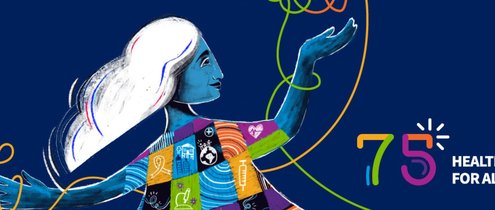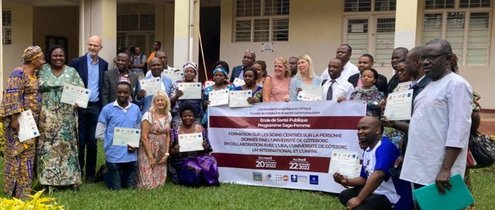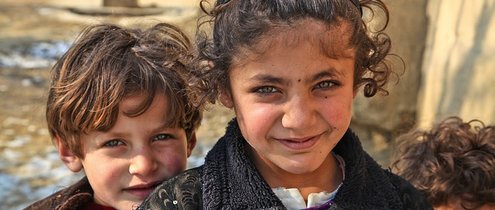Overview Universal health coverage ensures everyone has access to the health services they need without suffering financial hardship as a result. In December 2012, a UN resolution was passed encouraging governments to move towards providing universal access to affordable and quality health care services. As countries move towards it, common challenges are emerging -- challenges to which research can help provide answers. The World health report: research for universal health coverage focuses on the importance of research in advancing progress towards universal health coverage. In addition, it identifies the benefits of increased investment in health research by low- and middle-income countries using case studies from around the world, and proposes ways to further strengthen this type of research.
This growing repository holds publications, multimedia, toolkits, news and events with information and insights about integrated people-centred health services. Share your resources! Follow us!
This growing repository holds publications, multimedia, toolkits, news and events with information and insights about integrated people-centred health services. Share your resources! Follow us!
Publications
Countries are seeking ways to strengthen their financing systems to promote access to quality health services under their commitments to Universal Health Coverage. Chronic conditions account for a large burden of premature mortality, and gaps exist in patient receipt of recommended quality care. The objective of this publication is to describe experiences in purchasing arrangements and payment methods and how they have been used to attain quality of care and health outcomes for chronic conditions. The publication builds on the existing body of empirical evidence and newly commissioned case studies from Australia, Canada, Chile, China, Germany, Indonesia, South Africa, and Spain to better understand the design of different purchasing arrangements that aim to promote quality for chronic disease care. We identify lessons learned in alignment of payment methods with service delivery models, key design issues in quality and payment, supporting purchasing policies, and monitoring and evaluation. Recognising that no single model is applicable to all settings, the publication aimed to share lessons learned and best practices and identify areas for future research, particularly in low- and middle-income settings.
Multimedia
On 7 April 2023, the World Health Organization observed its 75th birthday. WHO’s 75th?anniversary year is an opportunity to look back at public health successes that have improved quality of life during the last seven decades. It is also an opportunity to motivate action to tackle the health challenges of today and tomorrow. #HealthForAll #WHO75 More information: https://www.who.int/campaigns/75-years-of-improving-public-health
In recognition of Universal Health Coverage Day, Management Sciences for Health convened a group of policymakers and practitioners on December 15, 2022, to examine person-centered primary health care as the foundation of achieving UHC and Sustainable Development Goal 3. Half-way into the lifespan of the SDGs, what needs to be done to ensure that communities are involved in the design of their primary health care systems? What are global best practices for primary health care and what are we learning from them? How can we ensure these experiences are brought to bear as we approach 2030?
Toolkits
Implementation science is a multidisciplinary field that focuses on studying and promoting effective strategies for translating evidence-based interventions (EBIs) into routine practice to improve outcomes in real-world settings. It has been increasingly used to document and assess interventions, as it helps to make sense of how, when, where, and why research results and EBI are, or are not, being successfully used. When compared to traditional project design, implementation, and management of health care interventions, implementation science can add value by addressing the specific complexities and challenges associated with implementing and scaling up these interventions. More specifically, it helps to analyze and understand the contextual factors, stakeholder dynamics, and system-level barriers that can hinder the successful adoption and integration of health care interventions. In this sense, by integrating implementation science principles the World Bank can tailor strategies, develop robust implementation plans, and leverage evidence-based practices to overcome implementation problems, which is particularly useful for primary health care interventions and other interventions targeted at improving health and nutrition outcomes at scale. It is important to consider implementation strategies that are responsive to context, as they help bridge the gap between EBI and implementation outcomes. Tailoring implementation strategies to the specific context enables implementers and managers to address barriers and leverage facilitators, thereby increasing the likelihood of success.
Forum to foster integrated community care in Europe and beyond A CALL TO ACTION Integrated community care (ICC) engages people and communities as co-producers of care. It implies a shift in traditional thinking based on problem-based, disease-oriented care to a goal-based, person-centred care aiming at improving population health and quality of life, with a particular focus on individuals and communities in vulnerable situations. This entails the development of new forms of collaborations across diverse contexts and settings. A key to such collaborations is the role of people in the community and in how service users (individuals, carer and families) become engaged and empowered as an integral part of integrated community care delivery. The Transnational Forum on Integrated Community Care (TransForm) is a learning coalition of philanthropic foundations in Europe and Canada that came together in 2018 with the aim to put the community at the centre of primary care and integrated care. Through a series of research activities, including a mapping of existing ICC practices in Europe and Canada, international conferences that included several site visits, and workshops, TransForm has identified, together with academics, decision-makers, practitioners, people with lived experience, and citizens the foundations of ICC – its key values, principles, ingredients, challenges and facilitators.
News
Today, 21 September 2023, at the United Nations (UN) General Assembly High-Level Meeting, world leaders have approved a new Political Declaration on “Universal Health Coverage (UHC): expanding our ambition for health and well-being in a post-COVID world”. The declaration is hailed as a vital catalyst for the international community to take big and bold actions and mobilize the necessary political commitments and financial investments to attain the UHC target of the Sustainable Development Goals (SDGs) by 2030. The UHC target measures the ability of countries to ensure that everyone receives the health care they need, when and where they need it, without facing financial hardship. It covers the full continuum of key services from health promotion to prevention, protection, treatment, rehabilitation and palliative care. Alarmingly, global progress towards UHC has been largely stagnating since 2015, before stalling in 2019. The urgency of the declaration is evident in the staggering statistics. At least 4.5 billion people—more than half of the world’s population—were not fully covered by essential health services in 2021. Two billion people experienced financial hardship, with over 1.3 billion being pushed or further pushed into poverty just trying to access basic health care – a stark reality of widening health inequities. “Ultimately, universal health coverage is a choice–a political choice,” said Dr Tedros Adhanom Ghebreyesus, WHO Director-General. “The political declaration countries approved today is a strong signal that they are making that choice. But the choice is not just made on paper. It’s made in budget decisions and policy decisions. Most of all, it’s made by investing in primary health care, which is the most inclusive, equitable, and efficient path to universal health coverage.” Turning point for course-correction In the Political Declaration, Heads of State and world leaders committed to take key national actions, make essential investments, strengthen international cooperation and global solidarity at the highest political level to accelerate progress towards UHC by 2030, using a primary health care (PHC) approach. For health care to be truly universal, it requires a shift from health systems designed around diseases to systems designed for people. PHC, an approach to strengthening health systems centred on people’s needs, is one of the most effective areas for investment to accelerate progress towards UHC. Countries that have taken a PHC approach have better ability to rapidly build stronger, more resilient health systems to reach the most vulnerable and achieve a higher return on health investments. Most importantly, they ensure that more people are covered with essential health services and are empowered to participate in making the decisions that affect their health and well-being. It is estimated that an additional US$ 200–328 billion investment per year is needed to scale-up a PHC approach in low- and middle-income countries (e.g. up to approximately 3.3% of national gross domestic product). This could help health systems deliver up to 90% of essential health services, save at least 60 million lives and increase average life expectancy by 3.7 years by 2030. WHO, through its network of more than 150 country offices and six regional offices, provides technical support to accelerate the radical reorientation of health systems through PHC focused approaches, and ensures robust normative guidance to track progress for accountability and impact. WHO commends Member States for approving the second UN High-Level Meeting Political Declaration on UHC, which was developed through a broad consultative process. WHO is fully committed to working with Member States and partners to ramp up policy actions for UHC to expand service coverage, ensure financial protection and shape the financing architecture to invest more and better in health. Once adopted by the UN General Assembly, the Political Declaration will be regularly monitored for implementation to identify gaps and solutions to accelerate progress, and discussed at the next dedicated UN High-Level Meeting in 2027.
A training course in person-centred care has been carried out in the Democratic Republic of the Congo by researchers at The University of Gothenburg Center for Person-centred Care (GPCC) in Sweden. The course participants had various professions such as midwives, nurses and physicians. The researchers can report on a very positive reception and great commitment, with the potential to have a great future impact.
Blog
Approximately 1 in every 10 children has a disability and in developing countries, fewer than one out of 10 of them go to school (1) (2). Persons with disabilities experience overlapping deprivations that contribute to marginalization, significant discrimination, and ultimately, exclusion in societal participation, perpetrating the vicious cycle of disability and poverty (3) (4). Early childhood is the time when the impact of disability into adulthood can be maximally mitigated. It is, therefore, crucial for identification to be carried out at the earliest possible instance and appropriate intervention is provided. In the Philippines, efforts are underway to implement a system on prevention, early identification, referral, and intervention for delays, disorders, and disabilities in early childhood in select subnational areas. This is a project that is being implemented through the national Early Childhood Care and Development Council and the Department of Health with support from UNICEF and Humanity and Inclusion. Important lessons can be taken forward from the design and initial implementation of this system. First, it was necessary to work around the locally existing Early Childhood Care and Development (ECCD) tool that has been normed for Filipino children ages 0-4 years. This tool is the ECCD Checklist Records 1 and 2 for children ages 0-3 years and 1 month, and those 3 years and 1 month to 4 years and 11 months, respectively. Because the tool targets two separate age bands that can be reached with distinct service delivery platforms, close collaboration between health and early learning services was necessary from design to implementation. Second, the design of the system had to be responsive to the local health and early learning systems context for the feasibility of implementation throughout the care pathway. This required several stakeholder consultations, the development of simplified tools and referral mechanisms across the care pathway, iterative revisions of these tools based on end-user feedback, and cadre-specific capacity-building activities. Third, in a middle-income country (MIC) with devolved governance, engagement and buy-in of the local chief executive (mayor or governor) for every town/city or province were critical for both effectiveness and sustainability. The implementation of the system involves more than one sector (health and social services) and local ordinances had to be drafted to support its institutionalization. Buy-in of local chief executives (LCE) also opened the possibility of having budget allocations in the annual local budgeting process. Finally, it cannot be overemphasized that identification of delays and disabilities is inevitably demand generating. This simply means that the supply side of the system has to be ready to respond to the demand that is being created and provide appropriate services for the children identified with disabilities. Therefore, for the initial implementation of this system, parallel work with service providers and other partners at both primary and referral facilities was necessary to ensure that there was some degree of supply-side readiness before the implementation. The initial gains in the upstream work on health financing that established the four social health insurance packages for children with mobility, hearing, visual, and developmental disabilities complement this downstream work and offers the possibility of eventual scale-up. Figure 1. System on Prevention, Early Identification, Referral, and Intervention for Delays, Disorders, and Disabilities in Early Childhood (simplified schema for the health sector) Bibliography UNICEF, WHO. Assistive Technology for Children with Disabilities: Creating Opportunities for Education, Inclusion and Participation (2015). Geneva : World Health Organization, 2015. United Nations Children's Fund. State of the World's Children 2013: Children with Disabilities. New York : United Nations Children's Fund, 2013. Poverty and Disability in Low and Middle Income Countries . Banks LM, Kuper H, Polack S. 12, 2017, PLoS One, Vol. 12, pp. 1-19. B, Rohwerder. Disability inclusion: Topic Guide. United Kingdom : GSDRC University of Birmingham, November 2015. World Health Organization and The World Bank. World Report on Disability . Geneva : World Health Organization, 2011. Ma. Bella P. Ponferrada, MD, MPH Former Health Specialist, UNICEF Philippines, worked with UNICEF Philippines as Health Specialist for Children with Disabilities and Integrated ECD in the First 1,000 Days, from September 2019 to August 2021.
There has been growing interest and experience of community health workers (CHWs) in recent years, especially with the goal of Universal Health Coverage. Typically, the CHWs have provided combinations of health promotion messages, treatment of childhood illnesses, malaria-control measures, nutrition interventions, family planning, and screening and supervised treatment for HIV and TB. Many CHW programs function semi-autonomously with supplies and supervision coming with varying regularity from health facilities. For many years, this community-based health care approach included the training of traditional birth attendants (TBAs). TBAs were, for the most part, given short training courses and sent back to their communities with little or no continuing connection with health facilities. The approach was halted twenty years ago when it became clear that trained TBAs were not making any impact on maternal and newborn deaths from complications of pregnancy and childbirth. A Skilled Birth Attendant (SBA) policy, to train and deploy greater numbers of obstetricians and midwives, has subsequently proven very effective. More recently, however, it has become clear that not all communities or all members of communities have benefitted equally, focussing greater attention on the social determinants of health. Afghanistan’s maternal and newborn health services illustrate these policies and trends. In 2002, the national maternal mortality ratio in Afghanistan was estimated at 1600 per 100,000 births. By 2014, that had been reduced to 660 (Ministry of Public Health). Three factors contributed to this improvement. The first was the end of war in 2002, followed by a time of improving prosperity, education, roads and transportation. The second was a government commitment to a policy of skilled birth attendance and the establishment of rural-based midwifery schools, which trained sufficient midwives to staff the newly established health infrastructure. The third was the training of 28,000 CHWs, a male and female in each community. These CHWs, especially the women, were able to provide health education, family planning methods and other primary care services to women who were still culturally constrained in their ability to reach health facility services. By 2010, the rate of SBAs had risen rapidly to 50%, but was only 22% in the most remote communities. The modern contraceptive prevalence rate was 20%. Sixty percent of women attended antenatal care at a clinic at least once, but only 18% completed the target of four attendances. National surveys have confirmed that the problems are the same as in so many countries, namely distance and the availability and costs of transport. Since 2010, there has been little improvement in use of these services. The emphasis on SBAs worldwide has not completely prevented explorations of the potential for community-based interventions by CHWs and TBAs. Field trials have shown successful implementation of presumptive treatment of malaria and provision of iron and folic acid tablets during pregnancy by CHWs. Programmes of preparation for a home delivery and the supply of delivery kits to help ensure a clean delivery and safe cord-cutting have well-recognised track records. In recent years, the supply of Misoprostol tablets to prevent postpartum haemorrhage in home deliveries has been shown to significantly reduce what is still the main cause of maternal death worldwide. Finally, many programmes have demonstrated the ability of CHWs and TBAs to provide basic newborn care, perform resuscitation, and both prevent and treat newborn sepsis. Recognition of the barriers to maternal care in health facilities for many families, together with the demonstrated potential of CHWs and TBAs to provide essential care suggest the potential of more integrated programs between facility and CHWs. In most countries, this requires removing the bureaucratic barriers between professional obstetric and midwifery care and community-based care programs. This, therefore, for example, is an important goal of the National Reproductive, Maternal, Newborn, Child and Adolescent Health Strategy, 2016 to 2021, for Afghanistan.








